MIPI DevCon Bangalore 2017: MIPI M-PHY Gear4 and Its Impact on UniPort/UFS
- 1. Roy Chestnut Director, Technical Marketing Teledyne LeCroy MIPI M-PHY® Gear4 and its impact on MIPI UniPortSM/UFS
- 2. © 2017 MIPI Alliance, Inc. Agenda • MIPI M-PHY • MIPI UniPro • UFS 2 Teledne LeCroy
- 3. © 2017 MIPI Alliance, Inc. MIPI M-PHY – Bursts and Gears – Gear 4 – New Attributes • Min_SAVE_Config_Time_Capability – ADAPT 3
- 4. © 2017 MIPI Alliance, Inc. Burst States • Burst States – Data transmission occurs in BURSTs with power saving states between BURSTs. – BURSTs can be transferred in HS-MODE or LS-MODE – The Min_SAVE_Config_Time_Capability attribute includes all implementation specific timings required to prepare for the reception of the next BURST after configuration during SAVE. – Each BURST starts from the SAVE state for that operating mode, with a transition from DIF-N to DIF-P. – After a period of DIF-P called PREPARE, a sequence of 8b10b encoded symbols – After the last 8b10b SYMBOL of the BURST either a series of b0s or a series of b1s (TAIL-OF- BURST) is transmitted. – A series of equal bits violate 8b10b code characteristics, and indicates whether the M-RX returns to the SAVE state of the current operating mode or enters LINE-CFG. – In the case of PWM signaling, the last bit of the sequence is inverted to indicate the end of LINE activity. 4 Teledyne LeCroy
- 5. © 2017 MIPI Alliance, Inc. Gears and Rates • HS-GEARs – A MODULE in HS-BURST shall only operate at the defined data rate, DRHS. – There are two RATE series, A and B, where each step in the series scales by a factor of two – RATES are used for Limiting EMI with the Cellular modem. – A MODULE that includes HS-MODE shall support both RATEs of a GEAR. – A MODULE supporting HS-MODE shall support HS-G1. If a higher GEAR is supported all lower GEARs shall be supported as well. 5 Teledyne LeCroy
- 9. © 2017 MIPI Alliance, Inc. ADAPT • ADAPT – The ADAPT sub-state is intended for the RX equalizer training – If an M-RX supports ADAPT, the PREPARE sub-state may be followed by the ADAPT sub-state for HS-G4. – ADAPT sequence starts with MK0 followed by an 8b10b encoded PRBS9 pattern – ADAPT sequence is completed by one b0 bit. – The 8b10b PRBS9 ADAPT sequence repeats every 650 bits. – ADAPT sub-state ends with the transmission of a TAIL-OF-BURST – M-RX and M-TX shall return to the STALL state. 9 Teledyne LeCroy
- 10. © 2017 MIPI Alliance, Inc. ADAPT • During initial discovery, the local protocol requests and reads capabilities of MODULEs on both sides of the LINK. • If HS-G4 equalizer capability is detected on both sides, updates the remote M-RX ADAPT length capability into its local M-TX ADAPT length configuration. – TX_HS_ADAPT_Length >= RX_HS_ADAPT_INITIAL_Capability • The local protocol shall update the following setting for a Refresh ADAPT: – TX_HS_ADAPT_Length >= RX_HS_ADAPT_REFRESH_Capability • When a HS-G4 BURST is initiated and ADAPT has been configured the M-TX transitions from PREPARE to the ADAPT sub-state instead of SYNC. • The M-TX transitions from DIF-P to transmitting the ADAPT sequence. • Both M-TX and M-RX remain in the ADAPT sub-state for the equalizer training for a duration of TADAPT • The M-RX signals exit from the ADAPT sub-state by flipping the ADAPT_Control field of RX_ADAPT_Control from ADAPT to SYNC and returning to STALL. 10 Teledyne LeCroy
- 11. © 2017 MIPI Alliance, Inc. MIPI UniPro 1.80 • New Link Startup Sequence • PACP Changes • Burst and Deskew • Quality of Service • New Primitives • Deprecated Functions 11 Teledyne LeCroy
- 12. © 2017 MIPI Alliance, Inc. Changes to Link Startup • Terminating a Link Startup • A UniPro Link Startup Sequence shall be aborted without reporting PA_LM_LINKSTARTUP.cnf_L(FAILURE) to the DME by either of the following conditions: – Local Application setting Power Mode to Hibernate_Mode or Off_Mode – Local Assertion of UniPro Cold Reset or UniPro Warm Reset • Error Processing during Link Startup • During Link Startup, the PA layer can only advance the Link Startup Phase – even when receiving errors on the incoming Link. • The PA Receiver should advance from Phase 0, Phase 1 or Phase 3 upon receipt of the correct TRG Symbols • The PA Receiver should ignore errors received during Phase 0 through Phase 4. • A PA_LM_LINKSTARTUP.cnf_L(FAILURE) should only be generated from a timeout. • HIBERN8 immediately after PA_LM_LINKSTARTUP.cnf_L(FAILURE), to prepare for a new Link Startup 1792 attempt from the local DME or the peer Device. 12 Teledyne LeCroy
- 13. © 2017 MIPI Alliance, Inc. PACP Changes • Gear 4 – PACP_PWR-REQ/CNF • Added value of 4 in the TX/RXGear field • Adapt – PACP_PWR-REQ/CNF • This field indicates the presence of ADAPT and type of ADAPT range (Fine or Course) selected for the current Power Mode Change • PACP_CAP_ind – MaxHS • This field shall be ignored by the PA receiver if PACP_CAP_EXT2_ind is received. • Instead, the MaxHS field of PACP_CAP_EXT2_ind shall be used. • If TX_HSGEAR_Capability is returned with value 4 or above, the PA transmitter shall set this field with value 2b’11 • In all other cases, the PA transmitter shall set this field with the value retrieved from TX_HSGEAR_Capability[1:0]. 13 Teledyne LeCroy
- 14. © 2017 MIPI Alliance, Inc. PACP Changes • PACP_CAP_EXT2_ind – The PACP_CAP_EXT2_ind frame is new – It supports all new capabilities introduced in M-PHY specification revision 4.0 onwards. – It is used in phase 5 of Link Startup Sequence before the PACP_CAP_EXT1_ind to notify the peer PA Layer of the local M-TX, M-RX, and PA Layer capabilities – Legacy Devices prior to UniPro version 1.8 not being able to recognize PACP_CAP_EXT2_ind shall – discard the reception of those PACP frames and proceed to PACP_CAP_EXT1_ind or PACP_CAP_ind – The frame’s fields are as follows • MaxHS: Maximum HS gear, or zero if HS mode is unavailable – This field overrides the field with the same name that is found in PACP_CAP_ind frame. • RxHsG4SyncLength: M-PHY timing information • RxHsG4PrepareLength: M-PHY timing information • RxHsAdaptInitial: M-PHY timing information • RxHsAdaptRefresh: M-PHY timing information – Unsupported or non-existing M-PHY capability attributes are reported with every bit set to '1'. 14 Teledyne LeCroy
- 15. © 2017 MIPI Alliance, Inc. Power Mode Changes • With MIPI UniPro Version 1.8 Only • Local PA Layer sends a PACP_PWR_req frame • When the remote PA Layer receives a valid PACP_PWR_req frame • The remote PA Layer shall send the PACP_PWR_cnf frame. • The local PA Layer receives a valid PACP_PWR_cnf frame • It checks the Status field. – If the Status field contains PWR_OK, PAPowerModeUserData is passed to the local DME. • The local PHY Layer wil be configured with the requested parameters. • The local PA Layer shall close the burst on the outbound Link. • The remote PA Layer shall close the burst on the other Link when detecting the end of burst on its inbound Link. 15 Teledyne LeCroy
- 16. © 2017 MIPI Alliance, Inc. Power Mode Change with Adapt 16 Teledyne LeCroy Local PA Remote PA PA_LM_SET.req (PA_PWRMode, x) PA_LM_SET.cnf_L (SUCCESS) PACP_PWR_req Idle Idle WaitCnf Configure MODULEs PACP_PWR_cnf WaitEoB Burst TX Burst TX Check cnf Configure MODULEs PACP_REQUEST_TIMER PACP_REQUEST_TIMER WaitEoB PA_DL_RESUME.indPA_DL_RESUME.ind Idle Idle PA_LM_PWR_MODE_CHANGED.ind (PWR_LOCAL) Check Capability Check Capability End TX Burst End TX Burst Remote DMELocal DME PACP_REQUEST_TIMER PACP_REQUEST_TIMER PA_DL_PAUSE PA_DL_PAUSE PA_LM_PWR_MODE.ind PA_LM_PWR_MODE.rsp_L PA_LM_PWR_MODE.ind PA_LM_PWR_MODE.rsp_L PA_LM_PWR_MODE_CHANGED.ind (PWR_REMOTE) TX Adapt Req Adapt TX PACP_REQUEST_TIMER PACP_REQUEST_TIMER PACP_REQUEST_TIMER PACP_REQUEST_TIMER Wait for Adapt Complete Ind from M-TX & M-RX Wait for Adapt Complete Ind from M-TX & M-RX Req Adapt TX TX Adapt
- 17. © 2017 MIPI Alliance, Inc. Burst Start and Deskew Pattern Burst Start and Deskew Pattern • An M-PHY burst shall begin by transmitting a deskew pattern <MK0, MK1>, • MK0 functions as an Start of Burst HEAD-OF-BURST marker. • The deskew pattern is also used when resynchronizing Lanes • The deskew pattern shall be transmitted simultaneously on all active Lanes. • The deskew pattern may be transmitted at any point in time for the purpose of potential error recovery • Dummy Burst • A dummy burst is an M-PHY burst that is sent on inactive M-PHY Lanes in a Multi-Lane scenario during Link configuration. • A dummy burst is to synchronize the M-PHY Lane attributes across both, inactive and activated Lanes • A dummy burst does not carry any payload and is not used in Lane distribution • A dummy burst is issued only on Lanes with a logical Lane number greater than 0. • The dummy burst shall begin by transmitting a special pattern <MK0, FLR>, which distinguishes the dummy burst from a normal burst. During the dummy burst, the PA Layer shall send only FILLERs. 17 Teledyne LeCroy
- 18. © 2017 MIPI Alliance, Inc. New Primitives – PA_INIT.ind • Informs the DL Layer that there was a PA_INIT requested by the Peer PA Layer. The DL Layer should notify the DME – PA_LM_RX_SYMBOL_CNT.ind • PA Layer generates this primitive every time it receives 1024 Symbols between the Head of Burst and the End of Burst – PA_LM_TX_SYMBOL_CNT.ind • PA Layer generates this primitive every time it transmits 1024 symbols between between HoB and EoB – M-LANE-AdaptStart – M-LANE-AdaptComplete – M-LANE-MRXSaveState – M-LANE-AdaptComplete 18 Teledyne LeCroy
- 19. © 2017 MIPI Alliance, Inc. MIPI UniPro Deprecated Functions in 1.80 • T-MPI: T-MPI avoids excessive pin-counts by utilizing high-speed SERDES technologies found in modern FPGAs. • LCC: LINE Control Command (LCC) • Basic Optical Media Converters are supported as optional • Advanced Optical Media Converters are not supported as options. – UniPro does not mandate the implementation of the M-PHY state LINE-CFG, nor does UniPro make use of the LINE-CFG state, should it be part of the M-PHY implementation. • UniPro specification Version 1.80 gives up backward compatibility to UniPro Versions v1.41.00 and earlier. Specifically due to deprecation of LCC 19 Teledyne LeCroy
- 20. © 2017 MIPI Alliance, Inc. UFS • General Features – Target performance – High speed GEARs • Support for GEAR1 is mandatory • Support for GEAR2 is mandatory • Support for GEAR3 is optional • Support for GEAR4 is mandatory 20 Teledyne LeCroy
- 22. © 2017 MIPI Alliance, Inc. UFS HS Burst • UFS HS Burst – A UFS device shall support the HS-GEAR1, HS-GEAR2 and the HS-GEAR4. – Support for HS-GEAR3 is optional. • This violates the M-PHY spec which states that all lower gears must be supported. – SUBLINKS in a LINK may communicate with different HS-GEAR or PWM-GEAR. • HS Prepare Length Control – The TX_HS_PREPARE_LENGTH M-PHY configuration attribute defines the time to move from STALL to HS-BURST. At reset, M-TX sets TX_HS_PREPARE_LENGTH = 15. • HS Sync Length Control – The TX_HS_SYNC_LENGTH M-PHY configuration attribute defines the number of synchronization symbols before a HS Burst. – In the UFS interface the synchronization sequence shall be generated by the M-TX. – Support for protocol controlled synchronization is optional. – M-TX starts at reset with TX_HS_SYNC_LENGTH = 15, in COARSE type. 22 Teledyne LeCroy
- 23. © 2017 MIPI Alliance, Inc. • PWM Burst • A UFS device shall support the PWM-G1 (default, mandated by [M-PHY]), PWM-G2, PWM-G3 and PWM-G4 GEARS. • The PWM-G5, PWM-G6 and PWM-G7 are optional. – Even if the physical layer supports PWM-G0, this gear can not be used because it is not supported by UniPro • The PWM-G1 is the active gear by default after power up or reset. • SUBLINKS in a LINK may communicate with different PWM-GEAR or HS-GEAR. • LS Prepare Length Control • The TX_LS_PREPARE_LENGTH M-PHY configuration attribute defines the time to move from SLEEP to PWM-BURST. • At reset, M-TX sets TX_LS_PREPARE_LENGTH = 10. 23 Teledyne LeCroy


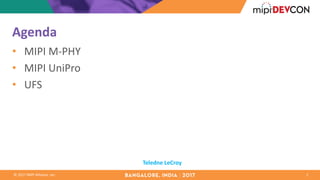
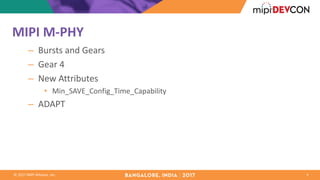
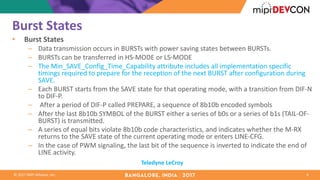

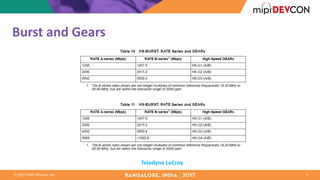
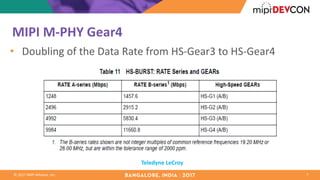

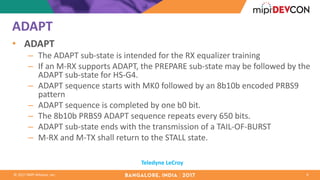
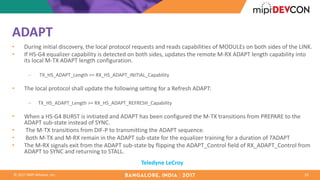
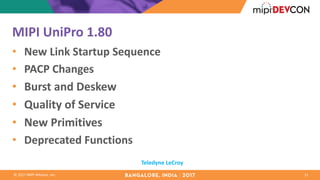
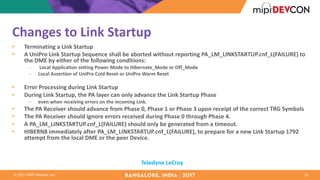
![© 2017 MIPI Alliance, Inc.
PACP Changes
• Gear 4
– PACP_PWR-REQ/CNF
• Added value of 4 in the TX/RXGear field
• Adapt
– PACP_PWR-REQ/CNF
• This field indicates the presence of ADAPT and type of ADAPT range (Fine or Course) selected for the current
Power Mode Change
• PACP_CAP_ind
– MaxHS
• This field shall be ignored by the PA receiver if PACP_CAP_EXT2_ind is received.
• Instead, the MaxHS field of PACP_CAP_EXT2_ind shall be used.
• If TX_HSGEAR_Capability is returned with value 4 or above, the PA transmitter shall set this field with value 2b’11
• In all other cases, the PA transmitter shall set this field with the value retrieved from TX_HSGEAR_Capability[1:0].
13
Teledyne LeCroy](https://image.slidesharecdn.com/bangalore-teledyne-lecroy-m-phy-gear4-and-its-impact-on-uniport-ufs-171110194929/85/MIPI-DevCon-Bangalore-2017-MIPI-M-PHY-Gear4-and-Its-Impact-on-UniPort-UFS-13-320.jpg)
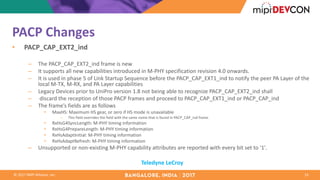

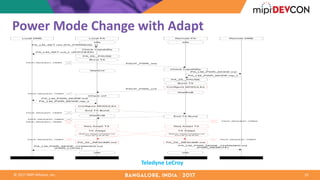
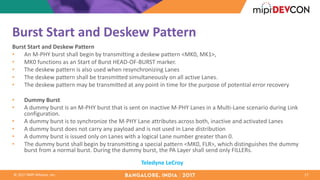

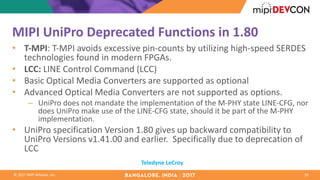
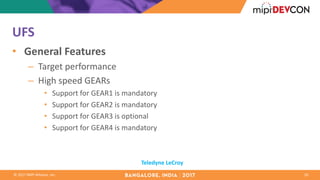
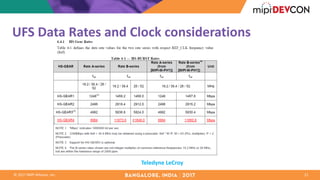
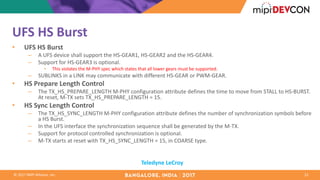
![© 2017 MIPI Alliance, Inc.
• PWM Burst
• A UFS device shall support the PWM-G1 (default, mandated by [M-PHY]), PWM-G2, PWM-G3
and PWM-G4 GEARS.
• The PWM-G5, PWM-G6 and PWM-G7 are optional.
– Even if the physical layer supports PWM-G0, this gear can not be used because it is not supported by UniPro
• The PWM-G1 is the active gear by default after power up or reset.
• SUBLINKS in a LINK may communicate with different PWM-GEAR or HS-GEAR.
• LS Prepare Length Control
• The TX_LS_PREPARE_LENGTH M-PHY configuration attribute defines the time to move from
SLEEP to PWM-BURST.
• At reset, M-TX sets TX_LS_PREPARE_LENGTH = 10.
23
Teledyne LeCroy](https://image.slidesharecdn.com/bangalore-teledyne-lecroy-m-phy-gear4-and-its-impact-on-uniport-ufs-171110194929/85/MIPI-DevCon-Bangalore-2017-MIPI-M-PHY-Gear4-and-Its-Impact-on-UniPort-UFS-23-320.jpg)
